WORDPRESS
Printful Review 2024: Your Ultimate Guide to Print-on-Demand

Printful Review 2024: Your Ultimate Guide to Print-on-Demand
As we enter 2024, the print-on-demand world is booming. It’s not just a trend; it’s a sustainable shift in e-commerce. I’ve dived deep into this market, focusing on Printful. This brand has made a big mark in the future of print-on-demand. With a growth rate of 25.8% until 2030, the industry is booming. Printful stands out with its quality products and reliable printing.
But how does it compare to other brands? In this honest review, I’ll explore what makes Printful successful. We’ll look at their shipping times and the details that make them a key business partner.
Printful Review 2024
Dive into my in-depth Printful Review for 2024; discover the print-on-demand service’s quality, pricing, and how it stacks up against alternatives.
Key Takeaways
- Understanding Printful’s role in the print-on-demand sector’s substantial growth projected through 2030.
- Assessment of Printful’s diverse print techniques, including Direct Garment and Embroidery.
- Evaluation of Printful’s product quality against the industry’s standards.
- Analysis of Printful shipping times in comparison to other market players.
- Insight into Printful’s customer service experience grounded in personal encounters.
- An honest reflection on the value Printful delivers for its pricing structure.
- Exploration of Printful integrations that streamline the print-on-demand workflow for sellers.
The Surge of Print-on-Demand
Printful Review 2024: Your Ultimate Guide to Print-on-Demand
The print-on-demand (POD) industry is booming, with a market value of $6.25 billion this year. It’s growing fast thanks to various products like custom t-shirts and die-cut stickers. These items are expected to grow even more, reaching $257.3 million by 2026. Printful offers over 344 items, meeting different customer needs.
Explosive Growth in the Print-on-Demand Market
POD stands out by avoiding the high costs of traditional retail. It offers unique items like all-over print yoga mats, fitting today’s health trends. With platforms like Shopify and Etsy, entrepreneurs can easily start selling various products, from pillows to golf balls.
Why the POD Business Model Attracts Entrepreneurs
POD is simple and efficient, drawing entrepreneurs with its low risk. Services like Printful only print products when ordered, reducing the chance of losing money. The demand for niche items like scarves and printed bed sheets shows the model’s flexibility and broad appeal.
Challenges in a Competitive Landscape
Even with its benefits, POD faces competition. Businesses must stand out. When comparing Printful with competitors, focusing on quality and service is key. Printful is highly rated, with a 4.6 Trustpilot score from over 4,000 reviews. Newcomers face the challenge of building trust and a loyal customer base in this competitive market.
In conclusion, the print-on-demand model is still going strong in 2024. With ongoing tech improvements and a growing product range, it’s becoming a big part of global e-commerce.
Success Through Innovation & Customer Service
Printful’s success comes from its focus on innovation and putting customers first. It offers advanced design tools and a white-label approach, which makes it easier for entrepreneurs to succeed in the competitive print-on-demand market.
Printful works well with e-commerce sites like Shopify, WooCommerce, and Etsy. Their easy-to-use interface shows their commitment to making things simple for users. They offer a wide range of products, from clothes to home decor. Each item is made with high-quality materials and the latest printing tech for the best quality.
Printful is open about its prices and has fulfillment centers worldwide. This shows how efficient they are and how they ensure fast delivery and reliable service. Their great customer service has made them a customer favorite, building a loyal base.
| Market Value | Projected Growth (2024) | Growth Drivers |
|---|---|---|
| $6.25 billion | 25.6% annually | Technological advancements, Social media influence, Online shopping trends |
| Home Decor Sector | $128.69 billion valuation | Increasing demand for customized home products |
Using platforms like Instagram and Pinterest helps Printful products get noticed. Targeted social media campaigns help reach more customers. Keeping the Printful store updated and fresh helps stay competitive by following SEO trends.
Printful’s success comes from offering top-quality products and great service. This makes it a top choice for those new to print-on-demand. It keeps customers returning and attracts new ones looking for reliable, high-quality products and excellent service.
What Makes Printful Stand Out
Printful Review: An Analysis of Printful vs Competitors
Printful is a top choice in the print-on-demand world. Its unique features appeal to new and experienced business owners. This article explores Printful’s unique features and what makes it different. We’ll focus on its special selling points, a Printful pricing comparison, performance, and what customers say.
Unique Selling Propositions of Printful
Printful is ahead with a wide range of products and customization options. This is more than what Printify and Gooten offer. They have everything from basic t-shirts to unique all-over shirts and posters. This variety meets many business needs.
Their focus on quality is clear. They have a strict quality check process. This lets merchants test designs at a lower cost, ensuring they’re happy before selling. They support up to 24 different platforms, making it easy for sellers to reach more customers. This broad product range and easy setup draw over a million merchants worldwide.
Comparing Printful’s Performance & Pricing With Others
Printful is competitive in Printful shipping times and costs, especially in Europe and the US. They offer flat shipping rates, making them a budget-friendly option for businesses in these areas. They’re known for fast and high-quality print product delivery. With 17 in-house printing facilities worldwide, they ensure quick and quality shipping.
| Feature | Printful | Competitors |
|---|---|---|
| Product Range | Extensive | Limited |
| Shipping Costs | Competitive Flat Rates | Variable |
| Customization Options | Varied and High-Quality | Standard |
| Integration Ease | 24 Platforms | Less Extensive |
| Quality Control | Rigorous Assessment Process | Standard Procedures |
| Customer Satisfaction | High (Trustpilot 4.6) | Moderate |
Looking at Printful’s pros and cons, the pros are clear. Yet, it’s important to note that Printful might cost more than local options. However, their wide customization, fast shipping, and global reach offer a strong value—something many others can’t match. These points highlight why Printful is a trusted name in the print-on-demand field.
Getting to Know the Catalog
Printful Review: Exploring Printful Products and Customization
Printful offers a wide range of options that make it stand out. With over 300 items, it meets various needs and creative desires. This variety boosts Printful’s reputation, making it a top choice among competitors.
Printful Review: Diverse Range of Printful Products
Printful has expanded its offerings to include unique items like all-over prints and embroidery. Its catalog of 343 items caters to many needs, from clothes to home products. Its ability to ship over 1 million items monthly shows its strong logistics and infrastructure.
The Customization Process and Quality Assessment
Printful is known for its customization options. It uses methods like DTG and Sublimation to create high-quality personalized products. Custom labels and embroidery add a personal touch, making Printful a top business choice.
Quality is key at Printful, as shown by their Trustpilot score of 4.6. Their reshipment rate dropped from 0.31% in 2020 to 0.26% in 2023, showing product quality and customer satisfaction improvements.
| Feature | Details | Impact |
|---|---|---|
| Product Diversity | 343 unique items | Wide range appeals to diverse markets |
| Custom Labels | Inside Label, Outside Label, etc. | Enhances brand visibility and product uniqueness |
| Printing Methods | DTG, All-Over, Sublimation, Embroidery | High-quality, durable prints tailored to product needs |
| Quality Rating | 4.6 on Trustpilot | Reflects high customer satisfaction and product reliability |
Looking into Printful’s catalog gives valuable insights into its offerings and strengths. It shows why they’re a top choice in the competitive market.
Understanding Printful’s Pricing
Printful Review 2024: Are You Getting Value For Money?
Looking at Printful’s pricing in the print-on-demand world is key. Entrepreneurs need to see how Printful compares to others. This helps them make a smart choice about using Printful.
Printful Pricing Comparison with Industry Standards
Printful’s basic t-shirt costs $9.50, about 58% more than a similar shirt from another company priced at $5.99. However, Printful’s premium plan offers a 20% discount on all products. They also offer up to 25% off on big orders and free shipping on orders over $50, which could save money for businesses ordering a lot.
Printful doesn’t require a minimum order and doesn’t charge monthly fees. This is good for businesses at any stage, whether they’re just starting out or growing. Because of its clear pricing, Printful might be a great deal even with a higher starting price.
The True Cost of Printful Products and Services
Using Printful is more than just the product price. It includes printing costs and shipping fees, which depend on the design and where it’s going. For businesses worldwide, Printful ships globally with big carriers. This helps businesses reach more customers without worrying about shipping.
Printful doesn’t usually discount big orders but offers 20% off on sample orders. This is great for testing products before a big launch. Plus, it works well with platforms like Shopify and WooCommerce, making starting an online store easier and safer.
It is key to look at Printful’s quality and customer reviews. Good production and happy customers mean Printful might be a smart choice. It offers value in product quality, customer service, and cost efficiency.
In conclusion, although Printful’s prices might initially seem high, the benefits are big. They offer discounts, no minimum orders, global shipping, and lots of customization. Printful is a great option for quality, flexibility, and growth.
Printful Review: Measuring Success
Analyzing Printful Shipping Times and Accuracy
As an e-commerce expert, I focus on Printful shipping today. It’s key to checking how happy customers are and how well the business runs. Shipping times greatly impact the customer’s experience. So, knowing how Printful handles shipping is very important.
The print-on-demand market is growing fast, set to increase by 25.8% each year until 2030. This shows a big opportunity for companies like Printful. However, they must keep shipping fast and accurately to meet customer needs.
Printful is staying ahead by using new printing methods and making packaging special. But, some customers say shipping is slow and not always clear. This shows the need for better shipping times and updates.
My goal is to offer my clients the best service possible. I keep an eye on shipping details. Printful customer service is crucial for businesses thinking about working with print-on-demand services. Printful needs to focus on making shipping fast and reliable.
Commitment to Customer Satisfaction
Printful Review: Insight Into Printful Customer Service
Printful focuses on customer satisfaction. They do this through great customer service and quick fulfillment services. These efforts help meet customer needs quickly and keep Printful products reliable.
Responsiveness & Quality of Support
Printful knows support is key in online shopping. They offer phone, live chat, and email support during weekdays. This means customers can get help quickly and easily, showing they care about their customers. Happy customers often leave good reviews and buy more.
Resolving Customer Issues and Returns
Sometimes, things don’t go as planned. However, Printful steps up to fix any quality or damage issues with clear return and refund processes. Remember, one bad experience could make 61% of customers switch brands. So, Printful works hard to fix problems fast and keep customers loyal.
Printful really cares about making customers happy. They focus on personal touches and understanding what customers want, which keeps shoppers returning. Their policies and actions show they get what customers need, making every interaction good.
If you need help with an issue or want to learn more about Printful products, the customer service team is here to help. They aim to improve your experience with Printful.
Leveraging Technology
Printful Review: How Printful Integration Options Streamline Business
In today’s fast-paced e-commerce world, using technology to stay ahead is key. Printful uses automation and works well with top online platforms. This shows how important it is for businesses to keep up with technology.
Ease of Integration with Popular E-commerce Platforms
Printful makes it easy for businesses to connect with big e-commerce sites like Shopify, WooCommerce, and Etsy. This lets merchants automate their order process, saving time and reducing mistakes. With these platforms offering thousands of apps and integrations, Printful users can improve and grow their stores.
Automation and Efficiency Benefits
Printful’s automation helps owners focus on growing their business, not just managing day-to-day tasks. This makes things more efficient and keeps printful fulfillment and shipping times consistent. This is key for keeping customers happy. Plus, working with platforms like Shopify lets users customize and improve their online stores even more.
Using these tech solutions, Printful is leading the print-on-demand market. It improves user experience and helps businesses run smoothly.
Printful Review: Real Experiences
Printful Review: A Compilation of Printful Customer Reviews
Exploring print-on-demand, the importance of real customer feedback is huge. We’ll look at Printful customer reviews to show what using the service is like. These reviews clearly show the good and bad, helping others make smart choices.
Customer Satisfaction and Feedback
Printful reviews show both positive and negative aspects. Most users like its ease of use, especially how it works with online stores. But some worry about the cost. For example, a Printful hoodie can cost almost $40 with shipping, taxes, and printing added.
Common Praise & Complaints
Looking into Printful reviews, we see what people like and dislike. Many praise the quality of their products. However, there are more positive reviews than negative ones, showing that most are happy, but some have issues. Complaints often mention mistakes like wrong sizes or damaged items, which worries brands that want to be reliable.
| Rating Level | Percentage of Reviews |
|---|---|
| 5-star | 78% |
| 4-star | 7% |
| 3-star | 2% |
| 2-star | 2% |
| 1-star | 11% |
Most users are happy with Printful, liking its ease and quality. But if you want faster shipping or lower prices, looking at Printful alternatives is good.
Printful Pros and Cons
Printful Review 2024: An Unbiased Assessment
Looking into a printful, honest review and looking at both the good and the bad is key. This helps us see what printful fulfillment services and printful customer service offer. Here’s a detailed look based on what users say and data analysis.
What Users Love About Printful
Printful is loved for its wide range of products and great customization. Users like the variety, which includes over 340 products like Adidas and Champion. Printful has also put over $83 million into top-notch printing tech, making products look great. Plus, it’s easy to use with platforms like Shopify, which has over 172,000 Printful app installs.
Where Printful Could Improve
Printful has some areas to work on, though. Some users don’t like the high prices, saying they’re too expensive. They also want more ways to use Printful, not just with main eCommerce sites. Ensuring that print quality is always good will also help build user trust.
Printful is great for its cool customization tools, quality products, and good customer service. But, they should work on pricing and making print quality consistent. This would make their service even better for users and meet market needs.
Printful Fulfillment Services
When looking into Printful fulfillment services, it’s key to grasp their full process and how Printful shipping times affect your business. They offer a one-stop solution from printing to delivery. However, several factors can make the process less efficient and reliable for e-commerce businesses.
Fulfillment Workflow and Effectiveness
It all started well; a small shop owner handled over 500 orders a month before using Printful in 2015. But, things can get complicated, especially when adding new products to their system, which some find time-consuming and repetitive. Also, dealing with out-of-stock colors requires a flexible and quick workflow to maintain Printful quality standards.
Fulfillment Timelines & How They Impact Your Business
Printful aims for a quick turnaround of 7-10 business days for printing and shipping. But, this can take longer during busy times. Delays are common, with Printful taking up to two weeks to send out replacements for wrong or damaged orders. It might take four weeks from the original order to get a replacement. This can really affect how happy customers are and how likely they are to stay with you, showing areas where Printful could improve.
These issues show customers’ thoughts, with many mentioning slow fulfillment and quality problems. These issues worsened during the COVID-19 pandemic, adding to customer service challenges. Printful tried to adjust and communicate during these tough times. But, the growing negative feedback highlights the need for lasting solutions to these problems.
In summary, Printful’s services are strong for e-commerce sellers. But, they face challenges with integration and handling high demand. Businesses should be ready for changes in service times and work on keeping customers happy. This will help keep your business strong and satisfied.
Printful Alternatives for Diversification
Printful Review: Make Money with Print-on-Demand
In the fast-changing Print on Demand (POD) market, sticking to one provider might not always meet all your needs. As a podcaster and content creator, I’ve looked into printful alternatives for more diversity and possibly better margins.
Why Consider Alternatives to Printful
Looking at printful vs competitors is not about being unhappy. It’s about making your business better. Even though Printful is great, other platforms might be better in certain areas, like product variety or pricing. Printful reviews praise its strong features, but every business has unique needs that might fit better with different providers.
Top Competitors in the Print-on-Demand Space
Here are some key players in the POD field:
- Merchize offers over 150 on-demand products, giving designers a wide range of options.
- Teespring, now Spring, has an integrated storefront that helps creators make money without upfront costs.
- Redbubble focuses on artists, offering a lot of independence and global reach.
Looking at them side by side shows diversification can be a growth strategy, not just a backup. Platforms like Merchize offer competitive shipping rates and low product costs.
| Platform | Product Range | Base Cost (T-Shirt) | Shipping Time |
|---|---|---|---|
| Printful | Wide | $12.95 | 3-5 days |
| Merchize | Very Wide | $5.00 | 1-6 days |
| Spring (Teespring) | Moderate | $10.57 | 3-5 days |
| Redbubble | Wide (Artist-centric) | Variable | 3-10 days |
Choosing from printful alternatives depends on what’s important for your business. This could be cost, product variety, or shipping speed. Each competitor in the printful vs. competitors debate offers unique benefits that might fit better with your business goals or market needs.
FAQs about Printful
Printful Review 2024: Your Ultimate Guide to Print-on-Demand
You’ll discover some frequently asked questions about Printful below.
How has the print-on-demand market grown, and what is its projected value by 2032?
The print-on-demand market has grown significantly, with a value of $59 billion expected by 2032, up from $6.25 billion in 2024. This growth is due to the rise in custom products like T-shirts and personalized home decor.
What attracts entrepreneurs to the POD business model?
Entrepreneurs like the POD business model for its low upfront costs and reduced inventory risk. It also makes customizing products easy, offering a unique approach to e-commerce.
What challenges do businesses face in the POD market?
Businesses face challenges such as standing out in a crowded market, managing product pricing and quality, and struggling with shipping and fulfillment processes.
What sets Printful apart from its competitors in the POD space?
Printful stands out with its top-notch product quality, many customization options, great customer service, and strong e-commerce platform integrations.
How does Printful’s print quality compare to other POD services?
Printful is known for its excellent printing quality, but quality can vary. They work with reputable brands to ensure quality, and customers praise their prints.
Are Printful’s pricing and services worth the investment?
Many business owners think Printful’s services are worth the cost. Their fulfillment system offers convenience and quality, making it a good value.
What are typical shipping times with Printful, and how accurate are they?
Printful’s shipping times vary, but they aim for efficiency with global fulfillment centers. While there are reports of inconsistencies, they work to fix these issues quickly to keep customers happy.
How responsive is Printful’s customer service?
Printful highly values customer service, offering quick support and clear refund policies for product issues. Customer feedback is mostly positive but shows some variation.
How do Printful’s integration options make running an online business easier?
Printful’s integrations with platforms like Shopify and Etsy automate order processing. This streamlines selling and reduces errors, saving business owners time and effort.
What are the most common praises and complaints found in Printful customer reviews?
Reviews often highlight Printful’s ease of use, product quality, and customer service. Common issues include pricing, shipping delays, and fulfillment mistakes.
What do users love about Printful, and where can Printful improve?
Users like Printful for its wide product range, innovative features, and focus on customer satisfaction. Areas for improvement include pricing, print quality, and shipping consistency.
What should I expect from Printful’s fulfillment services?
Expect Printful to handle printing and shipping for you. While convenient, there might be delays or errors. It’s key to communicate with Printful and set realistic expectations.
Why should I consider alternatives to Printful?
Looking at other POD services can lead to better prices, unique products, or services tailored to your business. It’s smart to check out different options to find the best fit for your needs.
Who are Printful’s top competitors in the print-on-demand industry?
Top competitors include Teespring, Redbubble, and other POD services. They offer competitive prices, unique products, or special features for different market segments.
Quick Links
Printful Review: Make Money with Print-on-Demand
We hope you enjoyed this post. If you did, you might want to check out these other resources:
Printful Review Summary
In my look into Printful for entrepreneurs starting in print-on-demand, I found a mix of new ideas, wide reach, and a strong focus on customer support. They offer over 230 products, from clothes to unique items like tableware and pet products. But it’s important to know that while many enjoy perks like up to five free sample orders and discounts for high sales, some see areas for improvement, like fulfillment issues and support problems.
On the bright side, most users are happy, with 79.3% giving it a top rating. This happiness comes from how easy it is to use with popular online stores, making it great for businesses, big or small. Printful also has a big reach worldwide, helping businesses grow globally.
In this honest review, I’ve looked at the good and bad to give a fair view. Printful has its ups and downs, but its focus on helping customers and always getting better might make it a key player in the print-on-demand world for a long time.
WORDPRESS
14 Best Email Management Software (Expert Pick for 2024)

While growing our online businesses, we have used a number of email management software options, such as Drip for our email newsletters and Groove for customer support. Along the way, we’ve experimented with different platforms for creating drip campaigns, building email lists, sending automated emails, and more.
However, after a lot of trial and error, we realized that not every email management software is built the same. Each has its own pros and cons, whether you are looking for a solution for customer support, email marketing, sales, or simply managing personal emails.
In this article, we will explain everything we have learned from testing the best email management software options on the market and help you choose the right one for your needs.

If you are in a hurry, then you can take a quick look at our top picks to make a decision.
| Rank | Software | Best For | Pricing |
|---|---|---|---|
| 🥇 | Groove | Customer support email management | $16/month per user |
| 🥈 | Constant Contact | Email marketing | $12/month + Free trial |
| 🥉 | Omnisend | Using email campaigns to boost sales | $16/month + Free |
| 4 | Gmail | Bloggers and individuals | Free |
How We Test And Review Email Management Software
Email management tools can help you organize, prioritize, and manage communication across your websites and online projects. This software can automate email tasks and be a great way to save time and increase productivity.
There are many different email management software for all kinds of WordPress sites, making it difficult to choose the right one. That is why we tested the most popular tools and paid special attention to the following criteria:
- Ease of Use: We have included email marketing tools that are beginner-friendly and come with extensive documentation to help you understand the product’s full potential.
- Different Use Cases: Each email software is built differently. That is why we have tried to include tools for different kinds of users, such as individuals, marketers, online store owners, and more.
- Email Support: We have recommended tools for sending and receiving customer emails to debug errors or troubleshoot problems.
- Email Marketing: We have prioritized tools for building email lists and sending engaging emails to bring back traffic.
- Email Management: You will find tools to manage emails sent by customers right in your dashboard. You can easily assign their queries to different support staff as well.
- Email Sales: Our list features software with a visual builder for creating abandoned cart emails, discount offer emails, and other conversion-boosting emails.
- Reliability: We have only included the email management software that we have tested ourselves on real websites.
Why Trust WPBeginner?
WPBeginner is a team of experts with 16+ years of experience in WordPress, email marketing, SEO, and more.
We extensively review and thoroughly test each tool in the list to give the best recommendations.
To learn more, see our editorial process.
Having said that, let’s take a look at our list of the best email management software.
Best Email Management Software for Customer Support
Customer support heavily relies on email communication to manage support tickets, contact users, and provide a consistent experience.
Here is a list of some best email management software for customer support.
1. Groove


Groove is the best email management software for customer support. It is super beginner-friendly and comes with features to provide amazing customer service to your users.
The software has a shared inbox for individuals, ensuring that customer emails are visible to the entire team. You can also manage your live chat and social conversations in the same inbox.
Other than that, Groove allows you to create a knowledge base for your customers. It also has 50+ automation templates to create request processes like auto-replies, conversation routing, conversation classification, and SLA management.


We were particularly impressed by the tool’s in-depth reports, which show key metrics like total resolutions, average resolution time, happiness rate, and more.
All of this combine to make Groove the best customer support service on the market. We actually use the tool across some of our own brands and have had a great experience with it.
Pros
- The Groove inbox can easily integrate with your Gmail account so you can easily check all your emails directly from the Groove dashboard.
- The tool allows you to assign conversations with customers to different team members in the inbox and has a private notes feature. It also has collision detection, which prevents task duplication and accidental edits on conversations between support members.
- We loved the software’s AI feature that turns specific customer responses into reusable instant replies in 1-click and generates summaries of lengthy conversations for easy reference.
- Groove can integrate with tools like Slack, HubSpot, Salesforce, GitHub, and more.
Cons
- Groove does not come with a free plan.
- It can only be integrated with WordPress using code.
Why we recommend Groove: We recommend Groove because it is the best help desk software that lets you manage all your emails directly from its dashboard, create a knowledge base, and assign conversations to different team members.
For details, see our Groove review.
2. Heroic Inbox
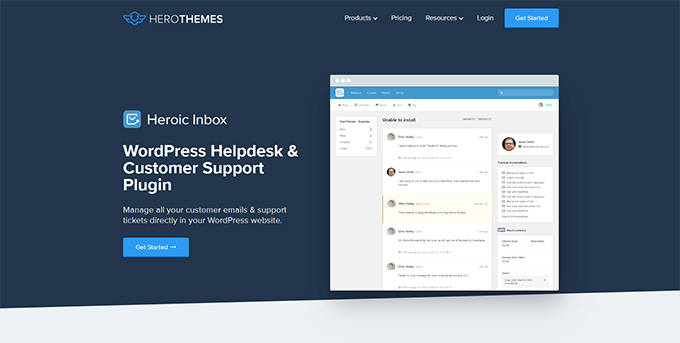

Heroic Inbox is an excellent help desk plugin that allows you to manage all your customer support processes right from the WordPress dashboard.
It lets you send pre-written responses when a new email comes in and manage all the emails on your admin dashboard without integrating with a third-party tool.
Heroic Inbox also comes with premade templates for frequently used responses that can boost email communication with customers.
Plus, it lets you compose emails and save them as drafts. This way, the team manager can review the email before sending it to the user.
Pros
- The plugin lets you categorize different conversations using email tags.
- Upon testing, we discovered that the plugin tells you when a customer opens up your email. It also has collision detection, autoresponders, and a ticket history feature.
- Heroic Inbox can integrate with Heroic KB to build documentation for your business.
- It offers a WooCommerce integration that lets users view their purchase history in your store.
Cons
- When reviewing the plugin, we didn’t like its integration process with Gmail because it’s not that beginner-friendly, and you must download a Google Workspace app for it.
- It has no free plan.
Why we recommend Heroic Inbox: This plugin is ideal for small to medium businesses who want to manage all their customer support emails right from the WordPress dashboard.
3. FreshDesk


FreshDesk is another customer service solution that lets you automatically convert incoming emails into support tickets.
It sets up rules to assign emails to specific agents or teams based on criteria like urgency, topic, or customer type. The tool also has a shared inbox where team members can collaborate on customer emails.
Additionally, FreshDesk has internal notes, canned responses, SLA management, and a collision detection feature to improve communication.
Pros
- We liked that FreshDesk keeps all email communication within a single thread. This provides a chronological history of the conversation for both agents and customers.
- The software has amazing features like creating a self-service portal through forum support, FAQs, a help widget, and AI automated voice responses.
- It provides in-depth analytics and reporting.
- FreshDesk also has live chat support and chatbots.
Cons
- If you have a small business, then using this tool can be overwhelming because it has a lot of features.
Why we recommend FreshDesk: FreshDesk is an affordable option for email management. It is ideal for businesses that are rapidly scaling and need to provide efficient support.
4. HelpScout
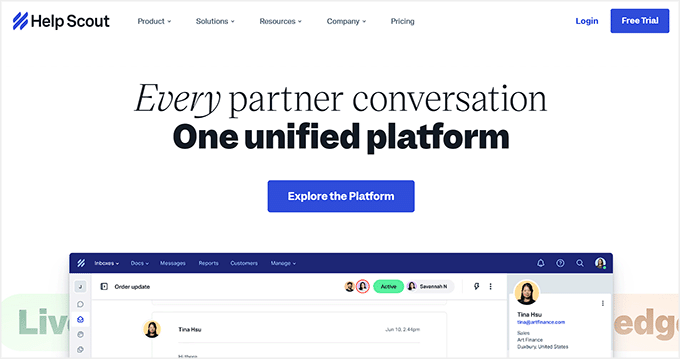

HelpScout is an all-in-one help desk software that manages all your chat and email support requests in a central place. It has a collaborative inbox to ensure that customer emails are visible to the entire team and makes it easy to create canned responses.
The tool can create automated workflows to set up autoresponders for initial replies, send saved responses for common questions, and trigger custom notifications based on email content.
It also has collision detection, internal notes, and a single email thread feature that takes customer communication via email to a new level.
Pros
- Upon review, we discovered that HelpScout lets you embed surveys directly within emails to gather customer feedback.
- The software comes with email routing, where you can set up rules to assign emails to specific agents based on different factors.
- We liked its AI Assist feature that provides suggestions to improve email drafts, including grammar fixes, conciseness adjustments, or tone modifications.
- It offers conversation ratings and analytics.
Cons
- Using HelpScout can become difficult as you scale up. This is because the tool is built for small to medium-sized businesses.
- It can be a bit expensive if you are on a shoestring budget.
Why we recommend HelpScout: If you have a small business site, then HelpSout is a great choice. It lets you manage emails in one place, uses AI to create better email responses, and can assign tickets based on different criteria.
Best Email Management Software for Marketing
If you are a marketer, then the following list of email management software will better suit your needs.
5. Constant Contact


Constant Contact is the best email management software for marketers because it has a user-friendly builder for creating attractive emails.
It lets you create drip campaigns and build automated workflows. For instance, you can send custom welcome emails, birthday messages, or abandoned cart emails.
The tool also lets you build and segment your contacts, making it a great choice to grow your email list.
Pros
- Constant Contact is the best email marketing service that lets you access unlimited emails, a free image library, and built-in social media sharing tools.
- We loved the customer support quality offered by the tool, including live chat, phone calls, email, community support, and a vast knowledge base.
- It has A/B testing to test different versions of your email subject lines, calls to action, or content.
- The tool has a great reporting feature that shows open rates, click-through rates, and other engagement metrics.
Cons
- Constant Contact allows you to build basic landing pages, but the customization options are limited.
- Some users have run into difficulties when canceling their Constant Contact accounts.
Why we recommend Constant Contact: If you are a marketer who wants to generate leads and bring more traffic to your website using emails, then Constant Contact is the best choice.
For details, see our Constant Contact review.
6. Brevo


Brevo (formerly Sendinblue) is a great CRM, automation, email, and SMS marketing software. It allows you to create abandoned cart emails, welcome messages, sales notifications, and more.
The tool also allows you to segment your email list, build automated email sequences, and test different versions of the emails to optimize their performance.
Additionally, you can use Brevo to manage email marketing right from your WordPress dashboard using the Newsletter, SMTP, Email marketing and Subscribe forms plugin.
Pros
- You can integrate it with landing page builder and eCommerce platforms.
- Brevo is an amazing SMS marketing software that lets you create automated SMS messages.
- We were impressed by its AI algorithms that select the best time to send bulk emails for the best email deliverability.
- You can also use this tool for CRM, live chat, and Facebook Ads.
Cons
- When researching the tool, we found that some users experience inconsistencies with email deliverability using Brevo.
- It only offers basic functions in the free plan.
Why we recommend Brevo: If you have a small business and are looking to launch email and SMS marketing campaigns, then Brevo is the best choice.
For more details, see our Brevo review.
7. HubSpot
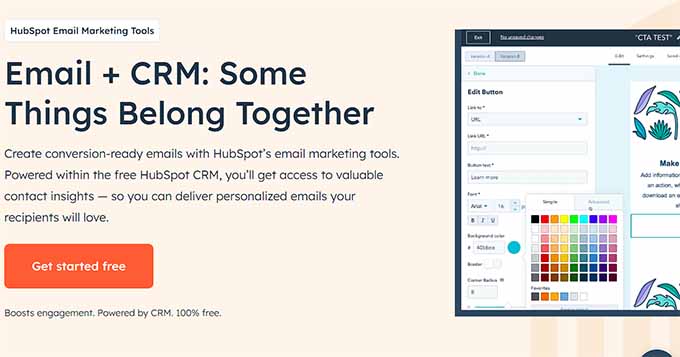

HubSpot is another CRM, email, and SMS marketing platform that can help you grow your contact list. It has customizable features to build an email list with your branding and uses AI to create subject lines and optimize your email copy.
It allows you to personalize email content based on criteria like recipient names, demographics, interests, or website behavior. The tool also lets you create automated workflows that can be triggered by form submissions, website visits, or abandoned carts.
HubSpot also has a comprehensive analytics feature that lets you know important information like conversion rates and unsubscribes.
Pros
- We loved HubSpot’s CRM (Customer Relationship Management) feature. It lets you organize and manage customer data for targeted email marketing campaigns.
- It has a high email deliverability rate and comes with A/B testing.
- You can create chatbots, WordPress forms, and landing pages.
- HubSpot has a free plugin that makes it easy to integrate the service with WordPress.
Cons
- The software has a free plan with limited features. However, its paid plan can get expensive.
- HubSpot has a lot of features, which can be overwhelming if you don’t plan on using some of the other features offered by the tool.
Why we recommend HubSpot: If you have a rapidly scaling business and want a tool to act as a CRM, email, and SMS marketing platform, form builder, and website builder, then HubSpot is the all-in-one solution for you.
8. AWeber


AWeber is one of the oldest email marketing software options around. It lets you build visually appealing email campaigns using dynamic elements that can adjust based on subscriber information.
The tool also offers features like list management, autoresponders, A/B testing, and email tracking with detailed insights, making it a great choice.
Plus, AWeber can seamlessly integrate with WordPress, allowing you to manage emails right from the dashboard. For details, see our tutorial on how to connect AWeber to WordPress.
Pros
- AWeber offers email marketing features such as AMP emails, automatic RSS-to-email for bloggers, and tag-based subscriber segmentation.
- It can integrate with popular WordPress membership plugins like MemberPress.
- The tool allows you to create customizable sign-up forms to embed on your website and grow your email list.
- When reviewing, we liked the tools’ powerful automated email sequence feature.
Cons
- The landing page builder in AWeber’s paid plans offers basic functionalities.
- Some of the premade templates have outdated designs.
Why we recommend AWeber: If you are just starting with email marketing, then AWeber is a good choice because it is super beginner-friendly and doesn’t offer an overwhelming range of features.
Best Email Management Software for Sales
If you have an online store and want to use emails to boost sales, then the following list of email management tools could be a good choice.
9. Omnisend
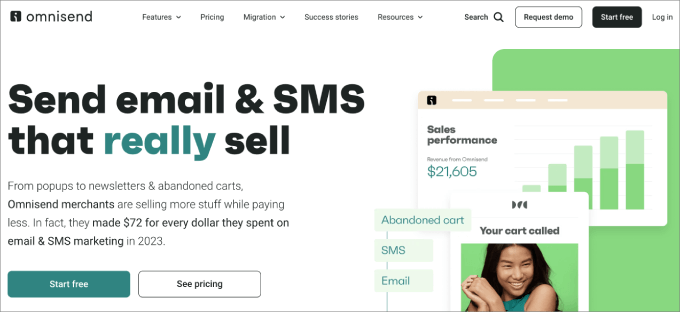

Omnisend is a well-known email marketing and automation platform for eCommerce websites. Its ‘Product Picker’ feature lets you create attractive emails with product recommendations.
Additionally, you can use the pre-built eCommerce workflows to set up email sequences for abandoning carts, promoting sale offers, and more.
Omnisend can also act as an SMS marketing tool, allowing you to send personalized messages to users with their names, locations, and other information.
Pros
- The software offers eCommerce-related features like customer lifecycle data, on-site behavior, message engagement, and more.
- When researching, we discovered that you can also send push notifications with Omnisend.
- It shows detailed analytics and reports on your marketing performance.
- You can also launch Facebook and WhatsApp message campaigns.
Cons
- Omnisend can be expensive if you have just started your online store.
- It can be a bit difficult to integrate it with other tools.
Why we recommend Omnisend: If you are looking for software that lets you send customized emails and use premade automated email sequences to recover abandoned carts, then Omnisend is the best solution for you.
10. Drip


Drip is another great platform for boosting sales by launching email marketing campaigns. It is also a powerful automation tool for creating workflows that are sent to users upon specific actions.
It is best known for creating drip campaigns, which involve sending a series of automated emails to customers at predetermined intervals.
Other than that, the software offers revenue tracking, A/B testing, and contact list segmentation, making it a great choice.
We even use it on WPBeginner for email marketing. For details, see our guide on why WPBeginner switched from MailChimp to Drip.
Pros
- Drip has a custom form builder and a landing page builder.
- It provides detailed reports on your campaign performance.
- The software can integrate with any eCommerce platform like Shopify or WooCommerce.
- We particularly liked the online courses and detailed documentation offered by Drip to better understand the product.
Cons
- The software can be super expensive and a bit complicated to use for small businesses.
- It doesn’t have a free plan.
Why we recommend Drip: If your WooCommerce store is rapidly growing, then Drip is a great solution for creating automated email sequences.
11. Streak
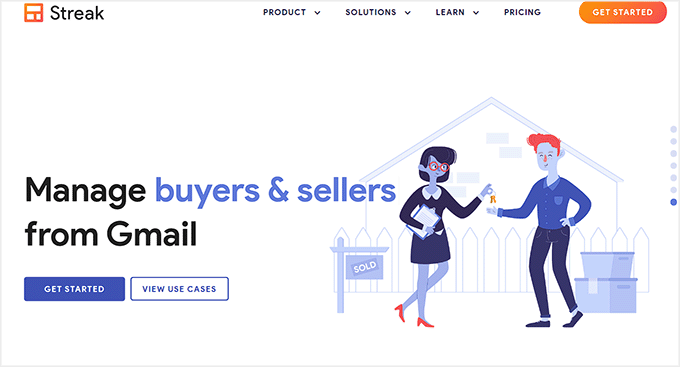

Streak is a software that is used to convert your Gmail inbox into a powerful CRM (Customer Relationship Management) tool. It can track all outgoing emails and see when recipients open them and click on links.
Other than that, it can personalize bulk emails with user data, schedule emails to be sent later, break down complex email threads, and allow email sharing with team members.
The tool can also generate reusable email templates for frequently used content snippets, saving you time and ensuring effective communication.
Pros
- Other than managing your emails, Streak can be used as a CRM. It can organize your leads, deals, and projects using customizable pipelines.
- We liked that the software allows you to track progress for each project using a Kanban-board-style interface.
- It allows you to store and manage all your contact information in Gmail.
- You can assign tasks to yourself or team members, set deadlines, and track progress within email threads.
Cons
- Streak only offers basic email tracking features.
- It does not allow you to create automated workflows or drip campaigns.
- Streak’s Kanban-style interface can become cluttered and difficult to manage with a large number of team members.
Why we recommend Streak: If you have a small online store and previously used Gmail to manage your emails, Streak is a good choice. It will work as a CRM and an email management tool, keeping everything in a central place.
Best Email Management Software for Individuals
If you have a WordPress blog that you manage by yourself, then you might be more interested in the following email management tools.
12. Gmail


Gmail is a free service developed by Google and is the most popular email management tool in the world. It allows you to send and receive emails easily and organize them in folders using labels.
You can also mark important emails with stars or use the built-in priority inbox to highlight critical messages that require immediate attention.
Plus, you can delete and archive multiple emails, undo sends, create pre-written templates, and access everything from your mobile.
For details, see our tutorial on how to set up a shared Gmail inbox for your WordPress site.
Pros
- Gmail has powerful search functionality, allowing users to find specific emails by sender, recipient, keywords, or other criteria.
- It can temporarily remove emails from your inbox and reschedule them to reappear at a designated time.
- The tool can seamlessly integrate with Google Docs, Google Calendar, and Google Tasks.
- The software offers a generous amount of storage space for your emails.
Cons
- Gmail is not as customizable as other dedicated email management platforms.
- It offers limited collaboration features.
- Managing a large team’s emails within a single Gmail environment can become overwhelming.
Why we recommend Gmail: If you have a simple WordPress blog and are not planning to send as many emails to users, then Gmail is a great choice.
13. Outlook
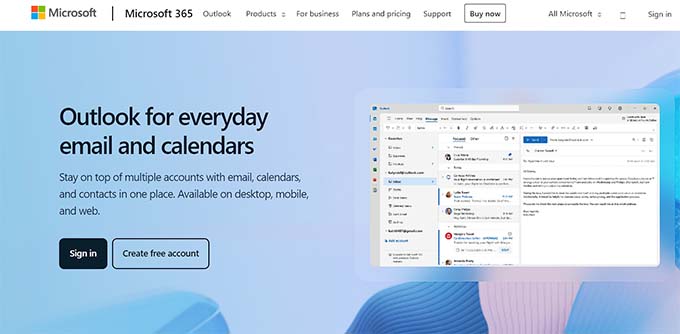

Outlook (formerly known as Hotmail) is another email management tool that is part of the Microsoft 365 suite.
It organizes all your email in a central inbox using categories, folders, and filters. Plus, it allows you to track whether recipients open your emails and see if they’ve clicked on links.
You can also create reusable templates with Outlook and schedule emails to be sent at a later date.
Pros
- It lets you create, manage, and share calendars with colleagues. You can schedule appointments, set reminders, and track deadlines.
- Outlook can also be used to schedule meetings with internal and external attendees.
- The tool lets you create contact lists and groups to send segmented emails.
- You can also create to-do lists with Outlook.
Cons
- It does not have any email marketing features.
- A free Outlook account only comes with basic customer support.
Why we recommend Outlook: Overall, Outlook provides a comprehensive suite of features for managing your emails, calendar, contacts, tasks, and more. It can be a great choice for personal and professional use.
14. ConvertKit
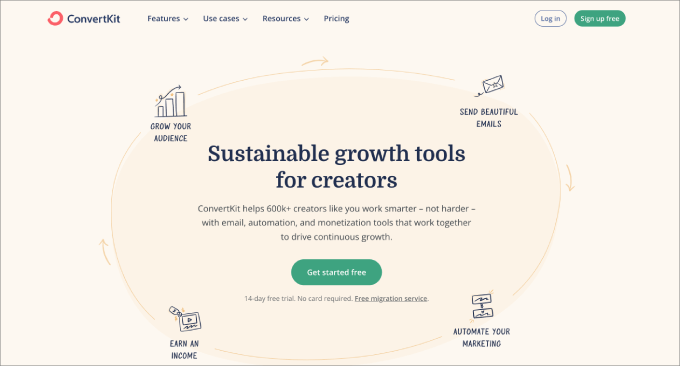

ConvertKit allows you to build engaging emails and complex automated workflows in just a few minutes. It has a beginner-friendly builder and reusable content blocks for efficient email creation.
The tool can be used to create landing pages and sign-up forms. You can also organize your subscribers with detailed tags and segment your audience for targeted email campaigns.
ConvertKit has an A/B testing feature to optimize your campaign performance.
Pros
- We liked that the tool lets you import existing contacts from other platforms and export your subscriber list for further analysis.
- You can use the software to sell digital products and offer paid newsletter subscriptions.
- The software allows you to set up automated email sequences for abandoned carts, welcome messages, onboarding processes, and more.
Cons
- You will need the premium plan to unlock ConvertKit’s automation features.
- The email templates have limited design flexibility.
Why we recommend ConvertKit: If you have a small business or blog but want to scale rapidly, then ConvertKit can be a good choice.
What Is the Best Email Management Software?
In our expert opinion, Groove is the best email management software for customer support because it is beginner-friendly. Plus, it offers features like shared inbox, auto-replies, conversation routing, and more.
You can also create a knowledge base and live chat widget with the tool.
On the other hand, if you want to use email to generate leads and bring back traffic, then Constant Contact is the best email marketing software.
It has beautiful email templates and a visual builder, lets you create drip campaigns, and offers a free image library.
However, if you have an online store, then we recommend Omnisend. It is a powerful automation and email marketing tool that is built with eCommerce stores in mind.
Similarly, if you just have a simple WordPress site, then you can use Gmail or ConvertKit.
Frequently Asked Questions About Managing Emails
Here is a list of some questions that are frequently asked by our readers.
1. How do I manage thousands of emails?
As your website grows, you will get more emails from customers every day reporting bugs or asking about your products. This can get very difficult to manage.
That is why we recommend using email management software. These tools offer various features to organize, prioritize, automate, and track your emails. They can also improve your overall email workflow and productivity.
2. What features should I consider when choosing email management software?
When choosing an email management software for your website, you should consider the following features:
- Ease of Use: You should opt for beginner-friendly tools that offer extensive documentation.
- Organization: The tool must offer basic organization features like labels, folders, filters, and search functionality.
- Automation capabilities: It should be able to create drip campaigns and have features like autoresponders, email sequences, and scheduling.
- Collaboration tools: The software must allow collaboration with other team members using shared inboxes, task management, and commenting.
- Integrations: It should have compatibility with other tools you use (e.g., CRM, project management).
3. How can I grow my email list?
There are many ways to grow your email list. For instance, you can add a contact form to your website, where users must add their email addresses to submit any queries about your products.
Or you can encourage users to sign up for your newsletter for a discount, use an exit intent popup, offer content upgrades, run giveaways, and more.
For more tips, see our tested and easy ways to grow your email list.
Related Guides for Email Management
If you liked this article, then please subscribe to our YouTube Channel for WordPress video tutorials. You can also find us on Twitter and Facebook.
WORDPRESS
11 Best Side Hustles to Take Up In 2024 For Extra Income

The concept of a side hustle has evolved dramatically in recent years. Once seen as a temporary means to make ends meet, side hustles have now become a mainstream way for people to diversify their income streams, pursue passions, and achieve financial goals. As we enter 2024, the gig economy continues to expand, offering more opportunities than ever for people to earn extra income. Whether you’re looking to supplement your full-time job, save for a big purchase, or even transition into self-employment, there’s a side hustle out there for you. Here are the 11 best side hustles to take up in 2024.
1. Freelance Writing and Content Creation
As businesses increasingly rely on digital content to connect with customers, the demand for skilled writers and content creators has surged. Freelance writing offers flexibility, the opportunity to work on diverse projects, and the potential to earn a significant income. If you have a knack for storytelling, persuasive writing, or expertise in a particular niche, freelance writing could be an excellent side hustle.
- Platforms to Consider: Upwork, Fiverr, and Contently are popular platforms where you can find freelance writing gigs.
- Income Potential: Depending on your experience and the type of content, freelance writers can earn anywhere from $50 to $500 per article or more for specialized work.
2. Online Tutoring and Teaching
The shift towards online learning during the pandemic has created a sustained demand for online tutors and educators. Whether you excel in academic subjects, languages, or even skills like music or coding, online tutoring can be a lucrative side hustle.
- Platforms to Consider: Websites like VIPKid, Tutor.com, and Teachable allow you to connect with students and create courses.
- Income Potential: Online tutors can earn between $15 to $50 per hour, depending on the subject and your qualifications.
3. Dropshipping and E-commerce
E-commerce continues to grow, and with platforms like Shopify and WooCommerce, starting your own online store has never been easier. Dropshipping is an attractive option because it allows you to sell products without holding inventory. You simply partner with suppliers who ship products directly to your customers.
- Platforms to Consider: Shopify, WooCommerce, and Oberlo for dropshipping services.
- Income Potential: The income from dropshipping can vary widely, but successful stores can generate thousands of dollars per month.
4. Social Media Management
With businesses increasingly relying on social media for marketing, the demand for social media managers has skyrocketed. If you’re savvy with platforms like Instagram, Facebook, TikTok, and LinkedIn, you can help businesses grow their online presence, engage with their audience, and develop brand loyalty.
- Platforms to Consider: You can find clients through Upwork, LinkedIn, or by networking with local businesses.
- Income Potential: Social media managers can charge $300 to $1,500+ per month per client, depending on the scope of work.
5. Virtual Assistance
As remote work becomes the norm, the need for virtual assistants (VAs) has increased. VAs handle tasks like email management, scheduling, customer service, and even content creation. This side hustle is ideal for organized individuals with strong communication skills.
- Platforms to Consider: Upwork, Zirtual, and Belay are popular platforms for finding VA gigs.
- Income Potential: Virtual assistants can earn between $15 to $50 per hour, depending on their skill set and the services offered.
6. Podcasting
Podcasting has exploded in popularity, and it’s not just for entertainment—many podcasters earn money through sponsorships, advertising, and listener donations. If you have a passion for a particular topic and enjoy speaking, starting a podcast could be a rewarding side hustle.
- Platforms to Consider: Anchor.fm, Buzzsprout, and Patreon for monetization options.
- Income Potential: While it takes time to build an audience, successful podcasters can earn hundreds to thousands of dollars per episode through ads and sponsorships.
7. Stock Photography
If you have a good eye for photography, stock photography can be a passive income source. Websites like Shutterstock, Adobe Stock, and Getty Images allow photographers to upload their images and earn money each time someone purchases a license.
- Platforms to Consider: Shutterstock, Adobe Stock, and Getty Images.
- Income Potential: Earnings depend on the number of downloads your photos receive, but stock photographers can make anywhere from a few dollars to several thousand dollars monthly.
8. Blogging and Affiliate Marketing
Blogging remains a viable way to earn extra income, especially when combined with affiliate marketing. By creating content around a niche you’re passionate about, you can attract an audience and monetize through affiliate links, advertising, and sponsored posts.
- Platforms to Consider: WordPress for blogging, Amazon Associates, and ShareASale for affiliate marketing.
- Income Potential: Income can vary widely, but successful bloggers can earn anywhere from a few hundred to several thousand dollars per month.
9. Online Coaching and Consulting
If you have expertise in a particular field, offering online coaching or consulting services can be a highly profitable side hustle. Whether you’re skilled in business, fitness, life coaching, or another area, you can help others achieve their goals while earning extra income.
- Platforms to Consider: LinkedIn for networking, Zoom for virtual sessions, and websites like Coach.me.
- Income Potential: Coaches and consultants can charge $50 to $300+ per hour, depending on their expertise and the market demand.
10. Airbnb Hosting
If you have extra space in your home or a property you’re not using full-time, renting it out on Airbnb can be a lucrative side hustle. With the right location and amenities, you can earn a significant income by hosting travelers.
- Platforms to Consider: Airbnb, Vrbo, and Booking.com for short-term rentals.
- Income Potential: Depending on your location and the property, Airbnb hosts can earn anywhere from $500 to several thousand dollars per month.
11. YouTube Content Creation
YouTube remains one of the best platforms for content creators to earn money. Whether you’re interested in vlogging, tutorials, product reviews, or any other niche, you can monetize your channel through ads, sponsorships, and merchandise sales.
- Platforms to Consider: YouTube for content hosting, and Teespring or Patreon for additional monetization.
- Income Potential: Successful YouTubers can earn anywhere from $1,000 to $100,000+ per year, depending on their audience size and engagement.
How to Choose the Right Side Hustle for You
With so many options available, it can be challenging to decide which side hustle is the best fit for you. Here are some factors to consider:
- Time Commitment: Consider how much time you can realistically dedicate to a side hustle. Some opportunities, like freelance writing or virtual assistance, can be done part-time, while others, like running an Airbnb, may require more of your attention.
- Skill Set: Reflect on your strengths and interests. If you’re a strong communicator, consider tutoring or coaching. If you’re tech-savvy, e-commerce or social media management might be a good fit.
- Income Goals: Determine how much income you hope to generate from your side hustle. Some side hustles offer quick cash, while others may require more time to build but offer higher long-term potential.
- Flexibility: Choose a side hustle that fits your lifestyle. If you need flexibility, look for opportunities that allow you to set your own hours or work from home.
- Passion: Ideally, your side hustle should align with your passions. When you enjoy what you’re doing, it won’t feel like work, and you’re more likely to stick with it and succeed.
Conclusion
As we move further into 2024, the opportunities for earning extra income through side hustles are more abundant than ever. Whether you’re looking to build a full-fledged business or simply want to supplement your current income, there’s a side hustle out there that can help you achieve your financial goals. From freelance writing to Airbnb hosting, the options are diverse, and the potential for success is within reach.
Choosing the right side hustle involves considering your time, skills, and passions, but with the right approach, you can turn any of these opportunities into a profitable venture. So why wait? Start exploring these side hustles today and take control of your financial future in 2024.
WORDPRESS
Best Web Hosting For Small Business In 2024

Types of web hosting
As a small business owner, you’ll probably start with shared hosting or WordPress hosting due to their affordable and easy-to-use nature.
Shared hosting splits one web server’s resources — like bandwidth and data storage — between many websites. This limits how much content — like blog posts and landing pages — your site can store and how many monthly visitors it can handle, but it also makes shared hosting affordable. Low-cost shared hosting plans can usually accommodate up to 10,000 monthly visitors, while high-end plans can typically handle up to 400,000.
WordPress hosting is (typically shared) hosting optimized for WordPress, a content management system — CMS — for creating and organizing blog posts and other site content. This includes pre-installed WordPress and may include pre-installed themes or plugins and automated WordPress updates. Low-cost WordPress hosting plans can often accommodate up to 10,000 monthly visitors, whereas higher-cost plans can typically handle up to 400,000.
Cloud hosting stores a website in multiple data centers to improve uptime and loading speeds for users around the globe. This type of hosting is used by popular website builders like Squarespace. Many traditional website hosting companies also offer cloud hosting. Cloud hosting bandwidth varies a lot, but most plans can accommodate at least 10,000 monthly visitors, and scaling up as your site grows is often quite simple with cloud hosting.
Virtual private server — VPS — hosting involves creating several virtual servers within one physical server. Each virtual server has dedicated resources, like storage and bandwidth. This typically lets you store more data — tens or hundreds of thousands of large files like images and videos — and accommodate more traffic (often several hundred thousand monthly visitors) than shared hosting. You may also get to customize aspects of your server, like the operating system.
Dedicated hosting involves giving one customer a full physical server. Many dedicated hosting plans let you store 1TB or more of data and accommodate millions of visitors per month. However, these plans are expensive and can be complicated to set up, so I generally don’t recommend dedicated hosting for small businesses.
Performance
There are two ways a web host influences your site’s performance: uptime and site speed.
Uptime is the amount of time your website spends online. Most web hosting services guarantee 99.9% uptime, meaning that server issues won’t cause your site to go down for more than 45 minutes a month. Some go beyond this to guarantee as much as 99.99% uptime, meaning your site won’t go down because of server issues for more than four minutes per month.
Site speed is how long it takes for your website to load. As a general rule, shorter load times are better. There are a few things web hosts can offer to improve this aspect of performance:
- International data centers so you can choose a server close to your target audience and improve loading speeds for them.
- Caching tools to store key data in users’ browsers and improve loading times on repeat visits.
- Content delivery networks or CDNs to store data in several locations around the world, allowing users’ browsers to pull from the server closest to them.
Security
Keeping your data — and your customers’ data — safe is important, especially if you’re accepting payments or collecting sensitive personal information through your website. Your web hosting plan should provide at least two security tools:
- Secure socket layer — SSL — certification: A protocol that encrypts data sent to and from your website. SSL certification also indicates to Google, browsers and VPNs that your site is safe, and some browsers and VPNs won’t even let you open a site without it.
- Firewall: A software tool that filters out malware attempting to infiltrate your site. Some firewalls also provide protection from distributed denial of service — DDoS — and brute force attacks.
Some hosts also provide security provisions like malware scanning/repair to handle any malware that makes it through to your site and automated backups so you can quickly restore your site if something goes wrong.
Customer service
You should be able to reach customer service at any time of day or night via live chat, support ticket/email or phone. When you contact them, customer support reps should be fast to respond and knowledgeable enough to fix your issues in a timely manner.
This is one area where checking reviews is important. Companies always say their customer service is great, but that doesn’t make it true — look at sources like Trustpilot and our own web hosting reviews to see what real customers have experienced.
Price
There are a few things to keep in mind when considering web hosting costs:
- Contract length: You may have to buy a one-, two- or even three-year plan — and pay for all of those months up front — to access the best price.
- Renewal pricing: Many web hosts offer low introductory pricing and raise the cost significantly when the contract renews.
- Additional fees: You may need to pay extra for things like a domain name. You’ll also want to pay attention to transaction fees if you’re choosing an e-commerce plan through a website-builder-focused host like Squarespace or Shopify.
-
SEARCHENGINES5 days ago
Daily Search Forum Recap: August 14, 2024
-

 SEO6 days ago
SEO6 days agoGoogle’s AI Overviews Ditch Reddit, Embrace YouTube
-
SEARCHENGINES6 days ago
Daily Search Forum Recap: August 13, 2024
-
SEARCHENGINES7 days ago
Daily Search Forum Recap: August 12, 2024
-

 SEO7 days ago
SEO7 days agoFospha Unveils the Ultimate TikTok Playbook for Ecommerce Success
-

 AFFILIATE MARKETING7 days ago
AFFILIATE MARKETING7 days agoYou Can Better Sway Your Audience With This Marketing Strategy
-

 AFFILIATE MARKETING5 days ago
AFFILIATE MARKETING5 days agoMusk, Trump Hit With Federal Labor Charges Over Livestream
-

 SEO5 days ago
SEO5 days agoChatGPT Study Finds Training Data Doesn’t Match Real-World Use














